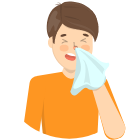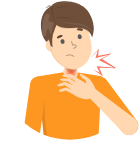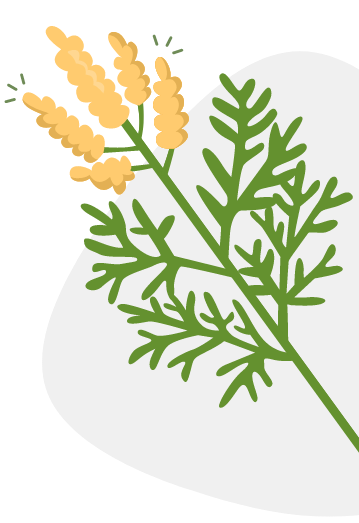Ragweed Allergy: Symptoms, Treatment and Definition
Seasonal allergies don’t just hit us at the height of spring and summer. If you’re still experiencing allergies in September and October, you may have a ragweed allergy.
Learn how to monitor and manage common ragweed allergy symptoms, and prepare for ragweed season – so you’ll have absolutely no reason to fear the Fall.
In this article, we’ll look at:
- What Is Ragweed?
- What Is A Ragweed Allergy?
- Frequently Asked Questions
What Is Ragweed?
Ragweed is a weed that’s part of the daisy family, especially noticeable for its leafy, ‘fern’-style appearance. The ragweed plant produces high levels of pollen – around a million pollen grains per plant every day – so it’s no wonder ragweed is responsible for the allergic reactions of so many people.
What Does Ragweed Look Like and Where Does It Grow?
When it blooms, the ragweed flower boasts yellow-green petals and sits on long green stems, with large spiky leaves.
Usually, ragweed plants grow in fields, gardens, waste areas and on roadsides all over the USA, but they’re most common in the eastern and midwestern states.
When Is Ragweed Season?
Unlike many seasonal allergens, ragweed pollen tends to cover the Fall months, so most people with a sensitivity to ragweed pollen notice that their allergies get worse in September and October.
Some people may see symptoms starting in late August, depending on the climate towards the end of the summer, while winter usually brings an end to the ‘season’. The ragweed flower tends to die out when the first frosts hit, as it can’t survive in low temperatures.
Ragweed pollen grains are incredibly light and can travel hundreds of miles in the wind. This means it spreads easily and quickly, and has the potential to affect people across a wide area.
What Is A Ragweed Allergy?
A ragweed allergy is essentially an overly-sensitive immune system response to ragweed pollen. When you breathe in the pollen, your body defends itself against the invader (even though it might be harmless) by producing chemicals known as histamines1. It’s these histamines that cause your allergic reaction, which in turn leads to the allergy symptoms you may be all-too familiar with
Ragweed Allergy Symptoms
Generally, ragweed allergy symptoms are very similar to any other pollen allergy, including grass or tree pollen. Common ragweed allergy symptoms include2:
- Sneezing
- Nasal congestion
- Irritated eyes
- Itchy throat
- Stuffy or runny nose
Some people also find that their ragweed pollen allergy aggravates existing conditions like asthma. This can sometimes lead to uncomfortable coughing and wheezing.
SYMPTOMS


SNEEZING


ITCHY THROAT


ITCHY, WATERY EYES


NASAL CONGESTION

ADVICE


PLAN AHEAD


COVER UP


REMOVE YOUR SHOES


TAKE A SHOWER


TRY AN ANTIHISTAMINE

Ragweed Allergy Treatment
Try these simple steps to help manage your allergy.
- Stay one step ahead of ragweed. The ZYRTEC® ALLERGYCAST® app shows you what pollen is in the air and how much of it is present with a daily pollen forecast. You can track your allergy symptoms too, which can help you plan your day (standard data rates for your plan apply).
- Cover up. When you’re outside in the late summer and Fall, try wearing hats, gloves, wrap-around sunglasses, and long-sleeve shirts to prevent contact with ragweed and other pollens.
- Remove your shoes. Kick your shoes off before entering your home to avoid bringing ragweed and other pollens inside, where they could stick to carpets and soft furnishings.
- Take a shower. After long periods outdoors, showering will help remove ragweed and other pollens from your skin and hair. If you don’t have immediate access to a shower (for example, if you’re at a friend’s house), you could try using one of our soothing wipes. You can run these over your hands and face to instantly remove particles as small as pollen, dust, dirt and other impurities.
- Try an antihistamine. ZYRTEC® antihistamines start working in just one hour, and can provide powerful, 24 hour relief of your ragweed allergy symptoms day after day. Learn more about the ZYRTEC® family of products.
FAQs
What other plants belong to the same family as ragweed?
The following plants belong to the daisy family, just like ragweed:
- Sage
- Mugwort
- Rabbit brush
- Groundsel bush
- Burweed marsh elder
Ragweed allergy symptoms may still develop if you come into contact with these plants, as the pollen might have a similar makeup. It will usually depend on how severe your allergy is and how similar the pollen is.
References:
- https://www.mayoclinic.org/diseases-conditions/hay-fever/symptoms-causes...
- https://acaai.org/allergies/types/ragweed-allergy
- https://health.clevelandclinic.org/allergies-got-you-fuzzy-headed-heres-...


